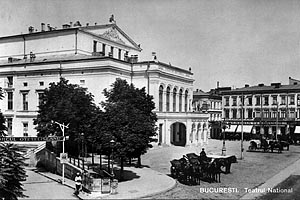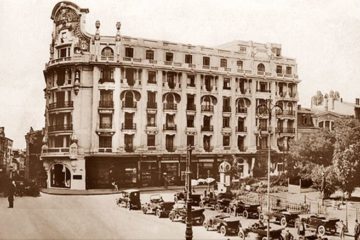
Te Ball – a hundred years of Romanian history
Starting in 1806-1812, the Moldavian-Wallachian aristocracy held the first balls for the Russian and Austrian officers present in the two principalities of Moldavia and Wallachia.
After the latter’s union in the year of 1859 and the formation of the young state of Romania, each nobility residence personalizes its social life by holding a ball. The best known were the February balls, the first of the year – held by the Soutzou family at their palace near the University or by the Știrbey family at their home on Calea Victoriei. Following those were the balls held at the respective residences of the Ghica and Sturdza families, and particularly the ones held by the royal family at the National Theatre, erected between 1842 and 1847, on Podul Mogoșoaiei, which is present day Calea Victoriei. We find out more about the etiquette and social rigours of these past events from Mrs. Sanda Tăttărescu Negroponte, who personally witnessed the last of the high society balls of these European and Romanian societies towards the end of the 1930s. “In those days, it was customary for the young girls, 16 to 18 years old, to make their debut. It was a privilege and a ball was held. This ball was offered to me, my father being prime minister at the time, by the French ambassador, Mrs. Thierry. It was a black and pink ball. The gentlemen wore a pink carnation, and the girls were dressed in pink and had a black carnation on the corsage. The high point in my life was my introduction at the English court. In 1938, my father was named the Romanian ambassador in Paris and he was adamant about me going to London, to conclude my studies there, him also being scared by the legionary resurgence at the time. In London I attended a ‘finishing school’, not for the diploma, but for the knowledge. That was after the baccalaureate. The school was at the ‘Monkey Club’, in fact three monkeys were on the school’s frontispiece: see no evil, speak no evil, hear no evil. It was a very well seen school, the life of a schoolgirl but of a higher level. The lady who was looking after me, the owner of the school so to speak, was lady Ascott, lord O. Ascott’s wife. He was the former English prime minister. One day she tells me: “You know, considering your father’s position, I think you could be one of the English court debutants”. And she got that for me; then followed the preparations for the English Royal Court, the special clothing, the feathers on the head, a lot of the things associated with this setting. Then came the introduction night, which was [something] to dream of. Of course, when I recount it today, or when I was recalling it in prison, I told myself “No, no, it couldn’t have been me! It’s obviously impossible that I had lived it!” And yet I had lived it.”
The balls
Around 1850, the “honourable police” divided the balls into a few categories, based on the spectrum of people that would be in attendance. The so-called “noble” balls were held in the former Slătineanu hall, across the road from Sărindar church; then the Bossel hall, across the road from the Oteteleșeanu residence. Then they moved to Bucharest’s palaces: Soutzu, Crețulescu, Știrbey etc. The most glamorous balls were held at the royal residences, and the great balls of the Romanian nobility took place at the Romanian Opera House, the Romanian Athenaeum and the Military Circle. The second rate or “semi-noble” balls were held at Pomul Verde (Hanul Roșu – nowadays the building is located near Curtea Veche); on Moșilor street and at Herasca, nearby Sf. Gheorghe Vechi; and on the Sfinții Apostoli street, where the “La Drumul de Fier” hall used to be. These two types of balls were part of the first order. Those of the second order, also called “society balls”, were held at the Bilcek hall, across the road from the Military School (the Pesta coffeehouse on a regular day).
The third order balls, or “common balls”, took place in nearly all of the suburbs. Amongst those still alive in Bucharest collective memory are Ianoș’s and Lukas’ balls, taking place in the Cișmigiu gardens, then the ball from the “Salcia Pletoasă”, on “ulița Flămândă”, in the blue paint (today the fourth district), by
the “Poor” church.
What did the ball mean for people 100 years ago?
Contemporaries make the point that, “the more noble [a ball], the colder and more sober it is.” Perchance the high etiquette governing them that generates this numbness? Meanwhile, in the higher halls “various languages, besides the national one, were spoken: German, French, Italian or Greek.” The social class gap was apparent even at public balls. Generally, “everyone seeks to party, to amuse oneself, to forget the everyday life”. In the Bossel hall one could see “most of the second, third, forth, fifth rate barons and nobility, plus the entire bourgeoisie, along with the gay and free social classes. The etiquette might be missing, but not the common courtesy. Each man, each youth matches their speech to their respective interlocutor’s.” Beyond the formidable socialization, the masked ball often removed the social barrier, thus fuelling a certain mystery, becoming more flexible and easily disposing of boundaries through the masks, enabling people to discover others outside customs, traditions or social taboos.
From balls to tea parties
Starting in the ’20s, balls began to give way to tea parties held by school, high school or universities; the noble balls or the charity balls, however, carried on (organized on special holidays such as Navy Day or the celebration of some institution). Many larger high schools and even trade schools, both in Bucharest and other Romanian towns, held their own respective balls, besides the ones at the end of the school year before the baccalaureate. After 1947, proper balls quickly faded out of existence. Thereafter, working class or “syndicate balls” were held, in factories or the newly spawned houses of culture, and sometimes in the proletarian mess halls. More than fifty years later, during which time this refined means of socializing has been largely absent, present days Romania again sees timid attempts at reviving these worldly and high-toned events alike.
By Adrian Majuru









